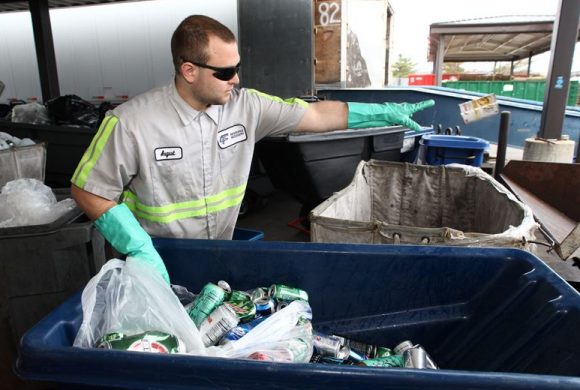When contracted for a building renovation project, you must put appropriate measures in place to reduce the amount of construction waste you generate and send to the landfills. Expert estimates reveal that the global annual waste generation stands over 2.2 billion tons. That’s quite a lot of pressure on the environment.
As such, you’d want to show your mindfulness by recycling construction waste where possible. This article presents seven practical recycling tips for your renovation project.
Partner With Local Recyclers

Renovation involves demolition of structural components of buildings, claddings, and numerous other fixtures and fittings. As much as you may try to reuse most of these, you’ll most certainly remain with waste that you need to dispose of. You’d want to partner with a local recycler to help you get rid of the waste in an environmentally friendly manner. They’ll usually supply you with skip bins for safe waste removal.
Make sure to hire several bins so that you can separate the different types of waste. That’s a requirement with most recyclers, as it makes their sorting work easier. And the faster the recycling firm is, the better for your renovation project. So, choose one that can come to your site within hours of requesting them to pick up a filled skip bin to enable you to dump more waste.
It’s also good to ensure the recycling company is located as close as possible to your construction site. This ensures you use little time, effort, and fuel to transport the construction waste, and that implies less environmental impact.
Prioritize Deconstruction Over Demolition

Avoid the thought of bringing a bulldozer to the construction site and flattening everything at the spur of a moment. While it’s a fast option, demolition yields a lot of unnecessary waste.
Instead, consider deconstructing the unwanted sections of the building under renovation. This way, you can salvage construction materials like bricks, doors, window frames, glasses, switches, pipes, ceiling boards, electrical conduits and wires, and reuse them on the same building or any other appropriate one.
Know What Construction Materials Are Recyclable
It’s critical for you to know the recyclable construction materials so you can appropriately segregate them from the non-recyclable ones set for land refills. Here’s a brief outline of these materials:
- Concrete: It can be broken and used as coarse aggregate for new concrete.
- Wood: Wood can be reused for construction or processed into wood chips for use as mulch, compost material, path material, livestock bedding, surface for kids’ play area, food for bugs, mushroom substrate, or fuel stove.
- Glass: Glass can be melted and used to produce new glass products.
- Metal: Recycling facilities can melt down metal and reuse in products like automobiles, aircraft, industrial containers, plumbing, ductwork, and house fixtures.
- Plastics: Plastic components such as switches, sockets, electric conduits, and plumbing fixtures and fittings can be recycled as long as the plastic they’re made from is recyclable.
- Asphalt shingles: These can be broken down and used to produce new asphalt.
Other recyclable construction materials include: brick, carpeting, cardboard, drywall, gravel, paper, roofing, baths, countertops, and sinks.
Integrate It Back Into The New Building

One excellent way to recycle construction waste is by using as much of it as possible in the new building. For instance, you can use demolished concrete as aggregate for fresh concrete. But make sure to apply reliable research findings so as not to compromise the compressive and tensile strength of the concrete.
For parts like masonry walls or drywalls, you really don’t have to demolish them. You can reconfigure or redecorate them by a new coat of paint or installing tiles.
Use Standard Dimensions
Several house components usually have standard dimensions used by a majority of builders. For instance, single doors measure 900 millimeters in width while double doors are 1,200 millimeters wide. The same applies to bathroom and kitchen sinks, bathtubs, windows, toilets, kitchen cabinetry, and garage doors.
You’d want to stick to the universally accepted dimensions instead of coming up with unique ones. This way, you won’t have to excessively cut sections of typical fixtures to adapt them to your unique dimensions. That means less wastage, and that’s a crucial component of recycling.
Use Recyclable Construction Materials

You agree that no building lasts forever. When your renovated building lives its time, a fresh round of renovation will still need to be done. Thus, you’d want to improve its recyclability by using recyclable components in the first place. For instance, you can use high-quality bricks and not-so-strong mortar to facilitate an effortless separation of the bricks during future deconstruction.
You can also limit the use of adhesives and other finishes that render construction materials non-recyclable. In the same sense, consider using recovered or post-consumer materials in your renovation project. These include building insulation, floor tiles, plastic fencing, restroom partitions, structural fiberboard, and carpet cushion, among others.
Train The Workers
It’s critical to ensure all your handymen are well-versed with recycling principles. Knowledge of waste segregation procedures helps save a lot of time. If properly done at the job site, there won’t be any need to do further sorting out.
So, make a point of training them on what construction waste is recyclable or reusable, what’s considered trash, and how to find value in trash.
Also, consider giving them incentives to encourage them to follow the predefined waste separation procedures. For example, you can add bonuses and give verbal praise every time your recycling partner finds the different construction wastes properly sorted out.
Minimize Construction Waste

There’s a possibility to reduce construction waste so that you don’t have an unnecessary burden to recycle waste. For instance, it’s proven that packaging of construction materials contributes to more than 10% of all waste.
On this account, you’d want to instruct the suppliers to limit the volume and quantity of packaging. The important thing is to receive the building components in a sound condition. If that’s possible with minimal packaging, then go for it.
Conclusion
At the current rate of generation of construction waste, it’s necessary to recycle as much of it and reduce the burden on the environment.
The tips above should help you in optimizing your recycling efforts in your renovation project. And doing so makes you an environmental conversation hero. It surely feels great to know that you’ve played a part in saving the ecosystem from ruin.



Leave a Reply